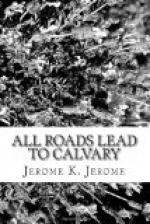Returning to the interior, Joan had duly admired the Cheyne monument, but had been unable to disguise her amusement before the tomb of Mrs. Colvile, whom the sculptor had represented as a somewhat impatient lady, refusing to await the day of resurrection, but pushing through her coffin and starting for Heaven in her grave-clothes. Pausing in front of the Dacre monument, Joan wondered if the actor of that name, who had committed suicide in Australia, and whose London address she remembered had been Dacre House just round the corner, was descended from the family; thinking that, if so, it would give an up-to-date touch to the article. She had fully decided now to write it. But Mary Stopperton could not inform her. They had ended up in the chapel of Sir Thomas More. He, too, had “given up things,” including his head. Though Mary Stopperton, siding with Father Morris, was convinced he had now got it back, and that with the remainder of his bones it rested in the tomb before them.
There, the little pew-opener had left her, having to show the early-comers to their seats; and Joan had found an out-of-the-way pew from where she could command a view of the whole church. They were chiefly poor folk, the congregation; with here and there a sprinkling of faded gentility. They seemed in keeping with the place. The twilight faded and a snuffy old man shuffled round and lit the gas.
It was all so sweet and restful. Religion had never appealed to her before. The business-like service in the bare cold chapel where she had sat swinging her feet and yawning as a child had only repelled her. She could recall her father, aloof and awe-inspiring in his Sunday black, passing round the bag. Her mother, always veiled, sitting beside her, a thin, tall woman with passionate eyes and ever restless hands; the women mostly overdressed, and the sleek, prosperous men trying to look meek. At school and at Girton, chapel, which she had attended no oftener than she was obliged, had had about it the same atmosphere of chill compulsion. But here was poetry. She wondered if, after all, religion might not have its place in the world—in company with the other arts. It would be a pity for it to die out. There seemed nothing to take its place. All these lovely cathedrals, these dear little old churches, that for centuries had been the focus of men’s thoughts and aspirations. The harbour lights, illumining the troubled waters of their lives. What could be done with them? They could hardly be maintained out of the public funds as mere mementoes of the past. Besides, there were too many of them. The tax-payer would naturally grumble. As Town Halls, Assembly Rooms? The idea was unthinkable. It would be like a performance of Barnum’s Circus in the Coliseum at Rome. Yes, they would disappear. Though not, she was glad to think, in her time. In towns, the space would be required for other buildings. Here and there some gradually decaying specimen would




